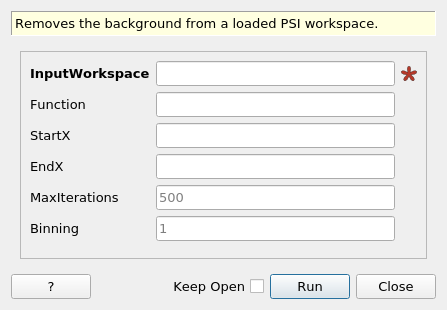\(\renewcommand\AA{\unicode{x212B}}\)
PSIBackgroundSubtraction v1¶

PSIBackgroundSubtraction dialog.¶
Summary¶
Removes the background from a loaded PSI workspace.
See Also¶
Properties¶
Name |
Direction |
Type |
Default |
Description |
|---|---|---|---|---|
InputWorkspace |
InOut |
Mandatory |
Input workspace containing the PSI bin data which the background correction will be applied to. |
|
Function |
InOut |
Function |
An optional fit function that will be added on top of the default FlatBackground and ExpDecayMuon functions, before the combined function is used for the background subtraction. |
|
StartX |
Input |
number |
Optional |
An X value in the first bin to be included in the calculation of the background. If this is not provided, it will use the first X found in the InputWorkspace. |
EndX |
Input |
number |
Optional |
An X value in the last bin to be included in the calculation of the background. If this is not provided, it will use the last X found in the InputWorkspace. |
MaxIterations |
Input |
number |
500 |
Stop after this number of iterations if a good fit is not found |
Binning |
Input |
number |
1 |
Constant sized rebinning of the data |
Description¶
This algorithm removes the background present in PSI bin data, loaded using LoadPSIMuonBin
The background is removed from the original data through the following formula,
where \(y_{cor}(t)\) is the corrected bin data, \(y_{org}(t)\) the original counts data and \(B\) is the flat background.
To obtain the flat background, \(B\), the second-half of the good raw-data is fitted with the following function,
where the first term represents a ExpDecay function, see ExpDecayMuon. The good raw-data is defined as being from the bin containing the first good data to the bin containing the last good data.
The algorithm takes in an input workspace and performs the correction inplace on the workspace. The number of iterations can be specified through an optional parameter. If a poor quality fit is returned, a warning will be displayed in the Mantid logger.
Usage¶
# import mantid algorithms, numpy and matplotlib
from mantid.simpleapi import *
import numpy as np
# Generate shifted ExpDecay data
A = 1200
Background = 20
Lambda = 0.5;
time = np.linspace(0, 10, 100)
func = lambda t: A*np.exp(-Lambda*t) + Background
counts = np.array([func(ti) for ti in time])
# Create workspaces
input_workspace = CreateWorkspace(time, counts)
input_workspace.setYUnit("Counts")
run = input_workspace.getRun()
run.addProperty("First good spectra 0",10,"None",True)
run.addProperty("Last good spectra 0",99,"None",True)
workspace_copy = input_workspace.clone()
# Run PSIBackgroundSubtraction Algorithm
PSIBackgroundSubtraction(input_workspace)
# Find the difference between the workspaces
workspace_diff = Minus(workspace_copy, input_workspace)
diffs = np.round(workspace_diff.readY(0),4)
# The counts in workspace diff should be a flat line corresponding to the background
print("Differences in counts are: {}".format(diffs))
Output:
Differences in counts are: [ 20. 20. 20. 20. 20. 20. 20. 20. 20. 20. 20. 20. 20. 20. 20.
20. 20. 20. 20. 20. 20. 20. 20. 20. 20. 20. 20. 20. 20. 20.
20. 20. 20. 20. 20. 20. 20. 20. 20. 20. 20. 20. 20. 20. 20.
20. 20. 20. 20. 20. 20. 20. 20. 20. 20. 20. 20. 20. 20. 20.
20. 20. 20. 20. 20. 20. 20. 20. 20. 20. 20. 20. 20. 20. 20.
20. 20. 20. 20. 20. 20. 20. 20. 20. 20. 20. 20. 20. 20. 20.
20. 20. 20. 20. 20. 20. 20. 20. 20. 20.]
import numpy as np
# Generate shifted ExpDecay data
A = 1200
Background = 20
Lambda = 0.5
time = np.linspace(0, 10, 500)
func = lambda t: A*np.exp(-Lambda*t) + Background + 0.5*A*np.sin(50.0*t)
counts = np.array([func(ti) for ti in time])
# Create workspaces
input_workspace = CreateWorkspace(time, counts)
input_workspace.setYUnit("Counts")
run = input_workspace.getRun()
run.addProperty("First good spectra 0", 10, "None", True)
run.addProperty("Last good spectra 0", 99, "None", True)
workspace_copy = input_workspace.clone()
# Run PSIBackgroundSubtraction Algorithm
function = "name=GausOsc,A=500,Sigma=0.2,Frequency=40,Phi=0"
PSIBackgroundSubtraction(input_workspace, StartX=5, EndX=10, Function=function)
# Find the difference between the workspaces
workspace_diff = Minus(workspace_copy, input_workspace)
diffs = np.round(workspace_diff.readY(0), 4)
# The counts in workspace diff should be a flat line corresponding to the background
print("Difference in first count is: {}".format(diffs[0]))
print("Difference in middle count is: {}".format(diffs[int(len(diffs)/2)]))
print("Difference in last count is: {}".format(diffs[-1]))
Output:
Difference in first count is: 20.0
Difference in middle count is: 20.0
Difference in last count is: 20.0
Categories: AlgorithmIndex | Muon
Source¶
C++ header: PSIBackgroundSubtraction.h
C++ source: PSIBackgroundSubtraction.cpp
